FROM JEDDAH TO RIYADH, we make the 500-mile journey on a pristine highway heading inland from the coast, skirting Mecca, climbing the Rift Valley escarpment and then traversing the unrelieved, pale flatness of the Arabian Desert. The road has clear purpose: linking Saudi Arabia’s two most important cities. Less clear is the purpose of the bridges that straddle it at regular intervals. There are no roads or rail tracks across them. They are bridges from nowhere, to nowhere.
The mystery remains unsolved until we see one in use. The silhouettes crossing from one side to the other are unmistakable: camels. The desert is their domain, and the highway sliced it in two. High fences to prevent the camels’ straying into the path of speeding vehicles enforce the sides of the road. The bridges, surfaced in sand and stone, link the two halves of the camels’ range. The animals cross back and forth without regard to the traffic below.
On first impression, Saudi Arabia’s great leap into the modern world seems to be unrestricted by environmental concerns: vast oil fields, refineries, multilane highways, high-rise cities. But look closely and you’ll find green issues move increasingly to the fore, enshrined most starkly in a decree made in March 2014 by a government agency, the Presidency of Meteorology and Environmental Protection, compelling all companies to meet new standards for air, water and noise pollution by 2019.
Saudi Arabia is the world’s largest producer of oil, and for decades the resultant wealth enabled the kingdom to shape its infrastructure without thought to sustainability. But now, with oil revenue sharply down and reserves declining, the kingdom seeks to diversify its economy and to create a future much less dependent on fossil fuel.
Sustainability is a priority for all new projects, many overseen by the Saudi Green Building Forum, an NGO counting major local construction companies such as the Binladin Group and Saudi Aramco among its members.
The SGBF is a crucial advisor to the kingdom’s biggest megaproject, a $93 billion new-build city taking shape on the shores of the Red Sea 60 miles north of Jeddah. The King Abdullah Economic City was conceived with sustainability as a central aim and a layout designed to prioritize walking, cycling and the use of public transport and to discourage private vehicles.
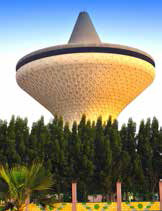
Water tower in Jeddah © AYED MOEED AL JEDAANI | DREAMSTIME.COM
Remarkably for a country still economically dependent on the export of fossil fuel, and where gasoline is still just 24 cents a liter, the new city will rely largely on renewable energy sources, especially solar power, another natural commodity this desert land has in abundance. On the flip side, water is scarce, and the city is going to great lengths to ensure responsible use, both during construction and in future day-to-day life.
Elsewhere in the kingdom, both Riyadh and Jeddah are currently being retrofitted with state-of-the-art public transport systems. The Riyadh Metro, to boast 85 stations, is due to open in 2018 at an estimated cost of $22 billion. The $8.5 billion Jeddah Metro, with 17 stations, is expected to start operating in 2020.
The most ambitious rail project of all is the Saudi Landbridge, an upgrade of the existing rail network that will link the Red Sea to the Arabian Gulf, with capacity to transport 8 million tons of freight each year, cutting the transport time from five to seven days by sea to just 18 hours.
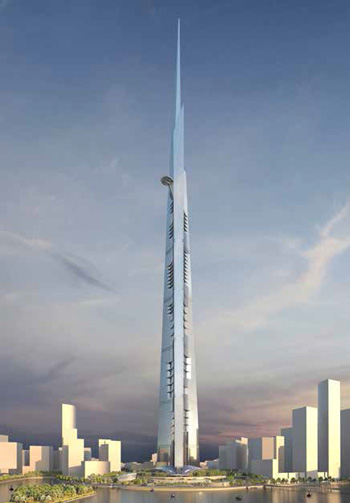
Kingdom Tower side
view © ADRIAN SMITH + GORDON GILL ARCHITECTURE
Of all the projects currently underway in Saudi Arabia, the one most likely to capture global attention is the 3,260-foot-tall Kingdom Tower in Jeddah which, upon completion in 2018, will be the world’s tallest building (Dubai’s Tower at Creek Harbour may regain the mantle when it tops out in 2020 — its ultimate height is still a guarded secret).
As with all other current Saudi megaprojects, the construction of Kingdom Tower supports efficiency and sustainability as key objectives, including low-conductivity glass to reduce the cost of keeping the interior cool during the ferociously hot summers.
For visitors, this highly conservative Islamic country can feel somewhat restrictive. LGBTQ travelers must necessarily keep a low profile (homosexuality is illegal). Women are not permitted to enter the country without their spouse, a male relative or a sponsor. All visitors are required to adhere to the conservative dress code. Alcohol is banned.
The Kingdom Tower, however, will be one of the few major buildings in the country that does not segregate men and women. It remains to be seen if it will stand as a symbol for a new direction in Saudi Arabia: more inclusive, more tolerant and more sustainable.
Things to do in Saudi Arabia
On a misty morning, wrapped up against the cold, we follow a trail through greenery. The fog burns off, revealing a breathtaking panorama of rugged mountains. Where are we?
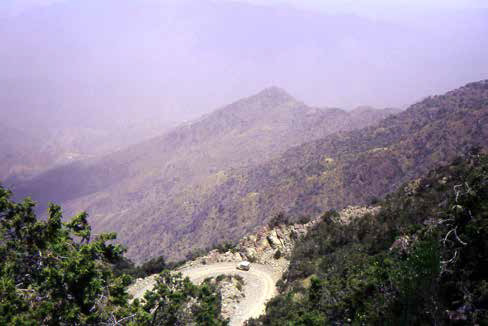
Winding road through Asir National Park © RICHARD NEWTON
Entirely subverting our preconceptions, we’re in Saudi Arabia, close to the city of Abha, in Asir National Park. Covering an area of more than 600 square miles, this precipitous park on the Rift Valley escarpment protects more than 300 species of birds, hamadryas baboons (a particularly hairy species of monkey) and the elusive Arabian leopard. Rising to 9,000 feet above sea level, the high-altitude park offers respite from the cauldron heat of the Arabian Desert, and with its diverse vegetation provides a striking contrast to the barren dunes.
Asir is not the only surprise this kingdom has to offer. Here’s another: Within sight of the skyline of Jeddah, we keel off the side of a boat into an explosion of bubbles. When the water clears, we find ourselves drifting above a coral reef teeming with life. Here in the Red Sea, as in the mountains of Asir, the aridity of the Arabian Desert seems a world away.
At Mahazat as-Sayd Protected Area, immediately to the south of the Jeddah-to-Riyadh highway, our preconceptions are finally met. This is more like the Arabia we imagined: a flat expanse of stark desert, interspersed with clumps of brush and isolated thorn trees. Here we encounter vultures, lone gazelles, a running flock of top-heavy ostriches and our ultimate goal, one of the great natural symbols of the region: the Arabian oryx.
A herd of these magnificent, straight-horned antelopes clusters in tree shade, watching us warily. They were hunted to extinction in the 1960s and were only saved thanks to a captive breeding program coordinated by the San Diego Zoo. This reintroduced herd is a beacon of hope for Saudi Arabia’s wildlife.
Saudi Arabia does not offer a great deal of tourist infrastructure. Asir National Park is best visited on daytrips from Abha, while access to Mahazat as-Sayd requires a permit from the Saudi Wildlife Authority. Red Sea diving is much more developed, with several dive operators based in Jeddah and 200 miles up the coast at Yanbu. All provide glimpses of the kingdom’s surprising diversity.
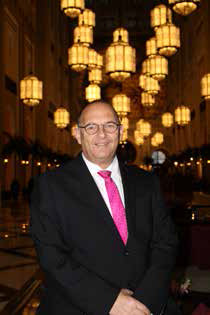
Paul Papanicolaou © MÖVENPICK RESORT AL NAWRAS JEDDAH
CHECKING IN WITH PAUL PAPANICOLAOU
General Manager, Mövenpick Resort Al Nawras Jeddah
How important are environmental considerations in the daily operations of Mövenpick Resort Al Nawras Jeddah?
Extremely important, especially given our location in the city built on an island. On a daily basis we collect, record and sort our waste and review our energy and water usage, recycling an average 2,000 kilos of waste per month. Being Green Globe-certified, our staff is fully aware of our targets, and all share in creating an environmentally focused resort. In addition, we are heavily involved in the community with various volunteer programs.
Would you say Saudi Arabia, in general, is becoming more environmentally conscious?
Without doubt, yes. There is a great awareness for the environment. Saudi Arabia has made it clear the protection and improvement of the environment is at the heart of its basic law, becoming an integral part of overall development planning in all projects in the kingdom, covering industrial, agricultural and architectural initiatives. Saudi Arabia has a 2030 vision plan focusing on using renewable resources, making the country more environmentally conscious.
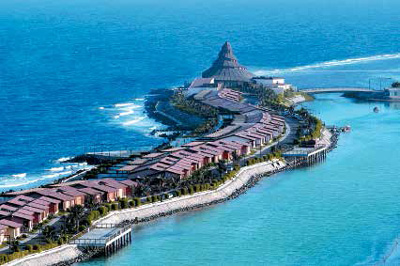
Mövenpick Resort Al Nawras Jeddah © MÖVENPICK RESORT AL NAWRAS JEDDAH
What cultural differences should Americans be aware of when visiting Saudi Arabia?
Saudi Arabian people are extremely hospitable and welcoming. If you can learn basic Arabic or the local greeting, you will find a different world can open up. Women should observe the Saudi dress code of wearing conservative, loose-fitting clothes including a full-length robe (abaya) and keep a scarf with them to cover their hair.
What are the key developments to look for in the future?
Currently there are many large construction projects for private enterprise and the government. In Jeddah we have the Corniche Development, which includes the Jeddah Eye (largest Ferris wheel in the world at about 780 feet), and we have the new airport, expected to open in 2017, including a new high-speed rail network to Mecca and Medina. We have the Kingdom Tower project, the tallest building in the world. In addition, we have construction at King Abdullah Economic City north of Jeddah, where they are building an entire city.
Which visitor attractions would you recommend?
Jeddah’s nickname, “Bride of the Red Sea,” is well-justified. You can enjoy some of the best snorkeling and scuba diving in the Red Sea. A visit to the Fakieh Aquarium provides something for all ages. Balad is the historic city center of Jeddah and a UNESCO World Heritage site. It is a great place to explore and find your own treasure in the many souks lining the streets.
Saudi Arabia Info to Go
Saudi Arabia’s busiest international entry point is Jeddah’s King Abdulaziz International Airport, 11 miles north of downtown, the staging post for pilgrims taking part in the annual Hajj to Mecca. The airport is nearing the end of a major expansion, upping annual capacity from 13 million to 80 million passengers. In terms of area, Riyadh’s King Khalid International Airport is the world’s second-largest airport, with connections to most corners of the globe. Most arrivals to Abha International Airport fly in via Jeddah or Riyadh, but there are also direct connections to Doha (DOH), Dubai (DXB) and Cairo (CAI).
Saudi Arabia: Just the Facts
Time zone: GMT +3
Phone code: Country code: 966 City codes: Riyadh 11, Jeddah 12, Abha 17
Key industries: Oil and gas, mining, construction, telecommunications
Currency: Saudi riyal
OFFICIAL LANGUAGE
Arabic, though English is widely spoken in business.
COMING AND GOING
All U.S. citizens require a passport valid for at least six months beyond arrival and a confirmed round-trip airline ticket. A visa is also required and should be obtained three to four weeks prior to arrival. If your passport contains evidence of travel to Israel or family links to Israel, it is likely your visa application will be rejected. Female travelers require a chaperone (husband, male relative or sponsor).
Where to Stay in Saudi Arabia
ABHA PALACE HOTEL This luxury hotel located on the western side of the city of Abha is convenient for trips to Asir National Park. Nahran Road, Abha $$$
INTERCONTINENTAL RIYADH Centrally located and offering 5-star comfort, this property benefits from IHG’s Green Engage system, monitoring and limiting environmental impact. King Saud Road, Riyadh $$$$
MÖVENPICK RESORT AL NAWRAS JEDDAH The Green Globe-certified resort offers private one- and two-bedroom villas facing the Red Sea on an exclusive island close to downtown. Prince Naif Road, Corniche Street, Jeddah $$$$
Restaurants in Saudi Arabia
19TH CENTURY BURGER This simple, no-fuss, international eatery is part of the fast-food chain inspired by the (disputed) origins of the humble burger, possibly invented in Hamburg, Germany. Ameer Sultan Street, Al Mohmmediah, Jeddah $$
ASSALAM PALACE REVOLVING RESTAURANT The 10th-floor restaurant offers spectacular panoramas of the city and its surroundings, but the view is better than the food, so come for lunch rather than dinner. Assalam Palace Hotel, Al Imam Muhammad Ibn Saud Street, Abha $$$
NAJD VILLAGE, RIYADH Enjoy traditional Arabian food in a traditional Arabian setting. Don’t expect tables; you eat crosslegged on the floor. Choose from two locations in the city. Al Takhassusi Street, Riyadh King Abdul Aziz Branch Road, Riyadh $$$
Read This Next
All Reads on This Topic
Read Them All

Introducing
FX Excursions
FX Excursions offers the chance for once-in-a-lifetime experiences in destinations around the world.
#globility
Insta FeedDaily
Dec 27, 2024Songtsam Hotels, Resorts & Tours Opens Newest Property in Yading, China
Songtsam Hotels Resorts & Tours, a luxury boutique hotel collection located in the Tibet and Yunnan Provinces of China, recently opened its 18th and newest property, Songtsam Lodge Yading. Located in Yading Village in China’s Sichuan Province, the 40-room property is surrounded by three stunning mountains, specifically the Three Sacred Mountains of Daocheng, known for representing wisdom, compassion and courage among locals.
Sponsored Content
Pick Your Paradise: Experience Bali at 3 Incredible Hotels
Bali is a name synonymous with island bliss. But there is more than just one side to this incredible place. Get a sense for the variety of experiences Bali offers by learning about three hotels participating in Marriott Bonvoy® with distinctive opportunities for adventure and relaxation. With the Marriott Bonvoy Boundless® Card, earn points for free nights at each of these properties.
Daily
Dec 27, 2024Latitud 32 at El Cielo Winery Unveils New Baja-Yucatán Fusion Menu
To celebrate its 11th anniversary, and earning a spot on the recommended restaurant list in the Michelin Guide’s historic first Mexico Selection, El Cielo Winery in Valle de Guadalupe announced the launch of its new Baja-Yucatán menu at Latitud 32. This fusion mixes the fresh, vibrant flavors of Baja California with the bold, aromatic ingredients of the Yucatán for a journey rich in taste.
Daily
Dec 27, 2024Park Hyatt Debuts Manhattan Suite
Park Hyatt New York recently debuted its new Manhattan Suite on the hotel’s 25th floor. Stays are now available starting at $50,000 per night with a two-night minimum.
Sponsored Content
Experience Next-Level Travel with Condor Airlines’ New A330neo Fleet
Condor Airlines completely renewed its long-haul fleet, featuring its new Airbus A330neo. Designed to elevate your travel experience, the A330neo is equipped with cutting-edge technology and offers unrivaled comfort, ensuring an exceptional journey for every passenger. With its striking signature striped livery, the A330neo not only promises a memorable flight but also enhances the start of your vacation from the moment you step aboard.
Daily
Dec 26, 2024Go on a Science-Inspired Tour with New Scientist Discovery Tours
British travel brand New Scientist Discovery Tours invites those with curious minds to join them for a science-inspired tour, cruise or expedition to provide a memorable and deeply enriching encounter with the world. Categories include history, archaeology, nature, astrology, marine, archaeology and “weekenders” — devoted to long holiday weekend journeys.
The Retreat Costa Rica Unveils $3 Million Expansion
Daily
Dec 26, 2024Hyatt Plans for 50-Plus Hotel Openings by 2026
Daily
Dec 25, 2024eFlyer News
Dec 25, 2024New Curio Collection by Hilton Hotel Opens in Breckenridge, Colorado
Sage Hospitality recently welcomed Hotel Alpenrock Breckenridge, Curio Collection by Hilton, to its award-winning hotel portfolio. The reimagined hotel underwent a top-to-bottom renovation to bring upscale modernity to one of Colorado’s most beloved destinations.
Sponsored Content
Discover the Pristine Beauty of the Sporades Islands
Nestled in the northwest Aegean Sea, the Sporades Islands are a hidden gem of Greece, offering breathtaking natural beauty and unique experiences for every traveler. Comprised of four main islands — Skiathos, Skopelos, Alonissos and Skyros — this island cluster is renowned for its lush pine forests, crystal-clear waters and idyllic beaches.
eFlyer Deals
Dec 25, 2024Earn Double Points on Your Next Hilton Stay This Winter
Attention all Hilton Honors members! Hilton just launched a new bonus-points deal on every Hilton hotel or resort stay this winter and next spring.
ShareThis